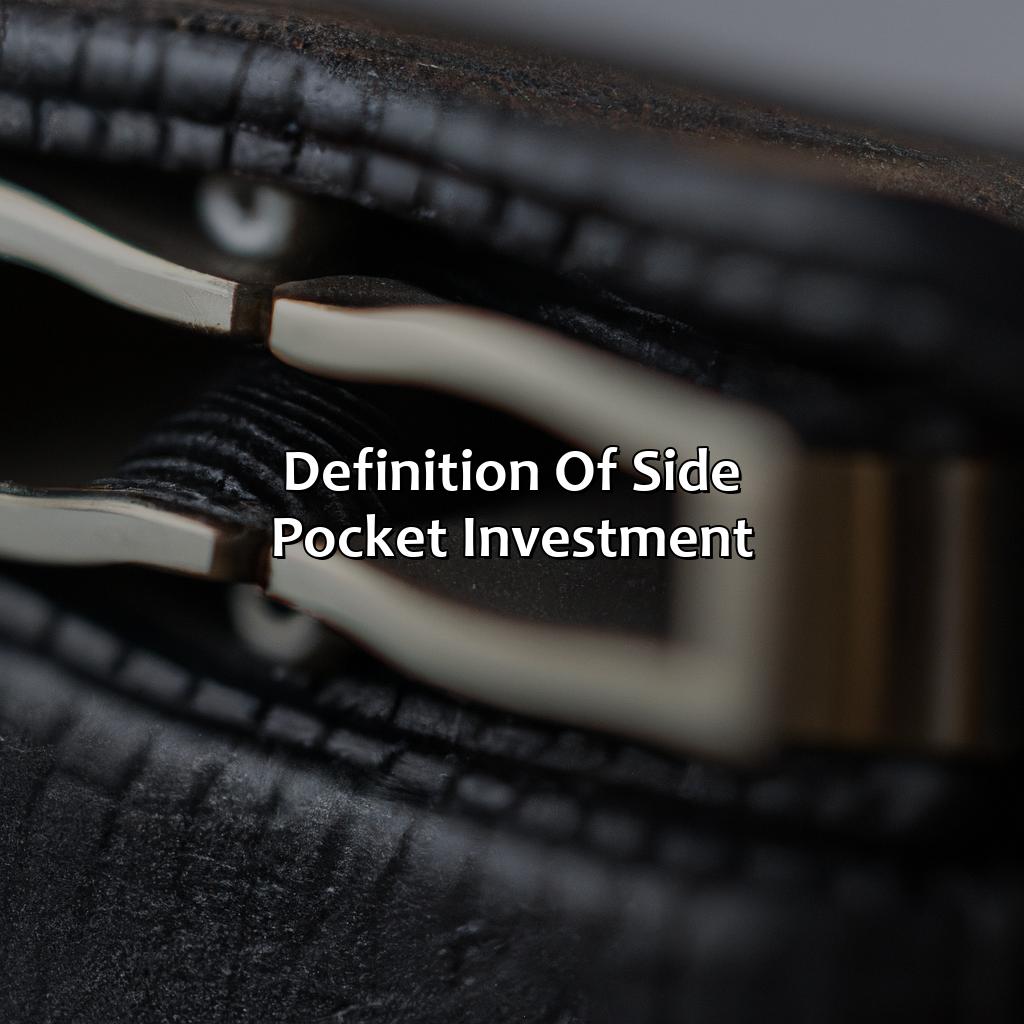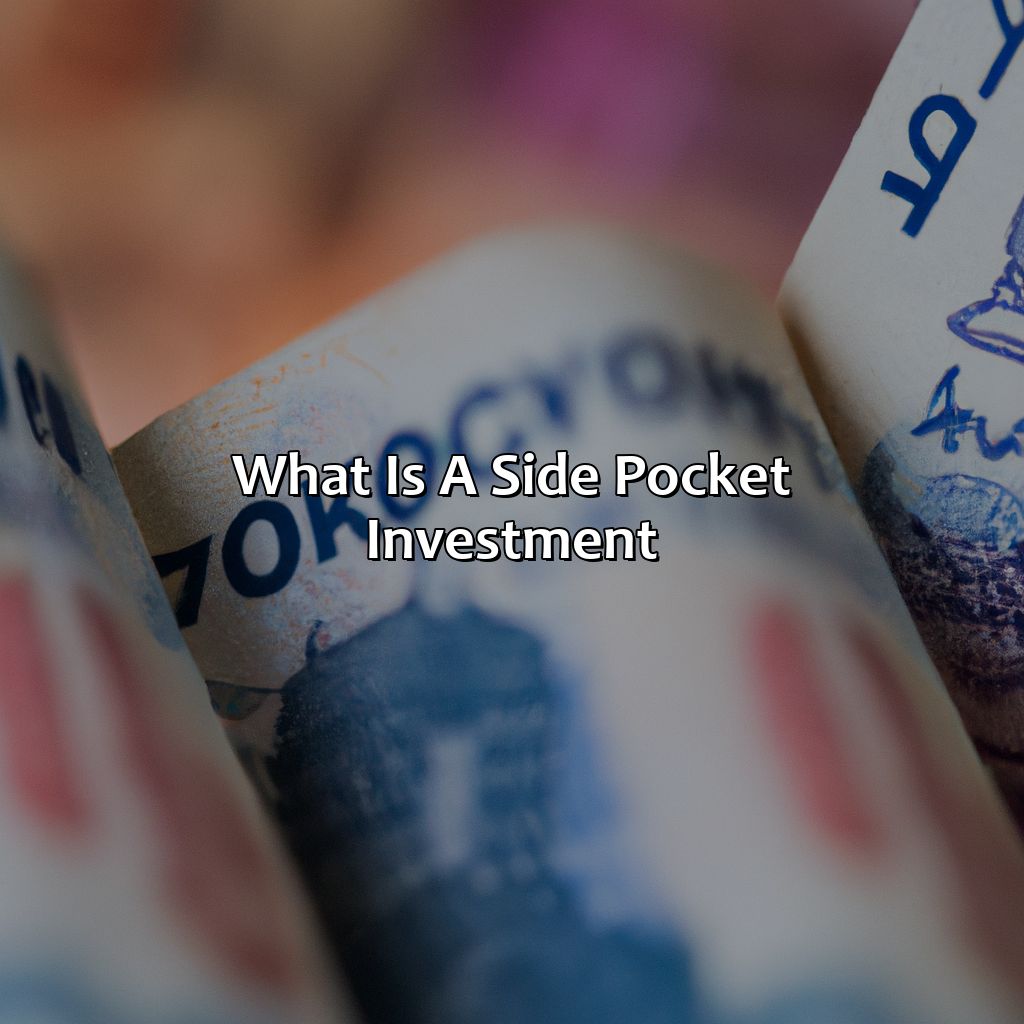What Is A Side Pocket Investment?
Key Takeaways:
- Side pocket investments are a type of investment where illiquid assets, such as private equity funds or hedge funds, are separated from a fund’s liquid investments to minimize risk and preserve value.
- One of the main advantages of side pocket investments is that they allow for better risk management by reducing exposure to potentially volatile or distressed assets. Additionally, side pocket investments have the potential to provide higher dividends than traditional investments due to their illiquid nature.
- However, side pocket investments also have several disadvantages, including limited liquidity and higher fees due to the specialized nature of the investment. It’s important to carefully consider these factors before investing.
Are you wondering what exactly a side pocket investment is? You’re not alone. With the increasing popularity of side pocket investments, it is essential to understand what this approach entails and how it can benefit your portfolio. Discover the advantages of this innovative investment tool here.
Definition of Side Pocket Investment
Side pocket investment is a mechanism that allows fund managers to segregate certain assets from a fund and hold them outside of the main fund’s portfolio. This means that investors can participate in the main fund without being affected by specific investments. Side pocket investments are usually used to hold illiquid and hard-to-value investments, such as private equity, real estate, and distressed debt. Managers can use this technique to preserve the value of the main fund and avoid dilution caused by the underperforming assets.
Moreover, side pocket investments are typically used when the assets cannot be sold at a fair price or when the valuation of assets is uncertain. Such situations can result in the underperformance of the main fund, which can negatively affect investors. By segregating these assets, fund managers can isolate risks and provide investors with transparency on their investments.
It is important to note that side pocket investments also have their limitations. One of the main drawbacks is that investors cannot withdraw from these investments until the assets are fully realized or transferred back to the main fund. Additionally, the valuation of these investments can be uncertain, which can make it difficult for investors to determine their actual value.
In light of these considerations, investors should exercise caution when considering side pocket investments. It is important to do thorough due diligence and carefully consider the risks and benefits of investing in these types of assets. Overall, side pocket investments can be a useful tool for fund managers to manage risk and protect the value of their portfolios, but investors should approach these investments with care.

Image credits: retiregenz.com by Adam Jones
Advantages of Side Pocket Investment
Side pocket investments are great for diversifying and managing your portfolio. They can help manage risk, provide dividends and preserve value. To learn more, explore this section! Grasping these sub-sections will give you a better understanding of the advantages of side pocket investments.

Image credits: retiregenz.com by Adam Arnold
Managing Risk
One of the key strategies for mitigating risk in investments involves diversification. A side pocket investment is a type of investment strategy that helps manage risk by segregating illiquid or potentially risky assets from the rest of a portfolio. This way, any negative impact caused by those assets will not affect the entire investment portfolio at once.
By creating a separate compartment for high-risk investments, investors can protect their investments from any potential risks associated with them. Side pocket investment is an effective way to ensure that different parts of an investor’s portfolio are independently managed and do not interfere with one another. This also helps reduce volatility and enhances overall returns.
Investors must be aware of the risks associated with side pocket investments and should consult with experts before taking any decisions. However, it is advisable to include this kind of risk-mitigating strategy as part of one’s overall financial planning activities to enhance the prosperity and stability of your investment portfolio.
Side pocket investments may provide dividends, but at least you won’t be crying over spilled losses.
Providing Dividends
Side pocket investment options not only provide dividends to investors, but they also offer various other benefits. Here are 6 points to consider:
- Investors can diversify their portfolio with side pockets.
- They provide security against bad debt risks.
- Retain cash for high-risk investments which has the potential of earning better returns.
- It makes calculations and bookkeeping much more manageable.
- The Investment Manager can efficiently handle distressed assets quickly without disturbing the existing strategy.
- It allows for unique tax harvesting opportunities and avoids cross-contamination by illiquid securities.
Additionally, Side Pocket options tend to have better tax efficiency compared to traditional investment options. A person with a short-term outlook can benefit from such investments if he/she invests in sectors that may not have immediate liquidity. It usually forms part of a structured arrangement between parties enshrined in agreement policies.
Pro tip: Always study the terms and conditions before entering into a side pocket investment deal.
Side pocket investments: because sometimes you need to protect your assets like a mama bear protects her cubs.
Preserving Value
Preserving the intrinsic value of an investment is crucial for ensuring long term profitability. Side pocket investments offer a unique advantage in this regard as they separate illiquid assets from other investments when their liquidity dries up. By doing so, it mitigates risks associated with sudden downturns or insolvency of these investments and ensures sustained profitability for investors. This benefit can be particularly useful in volatile markets where quick and smart decisions on illiquid assets become challenging.
Side pocket investments open up doors to alternative investment opportunities that may have limited liquidity but offer high returns. These assets may not be easily tradable due to legal, management or customer agreements and at times, they can create delays in the withdrawal process or increase redemption risk posed by other investors. By dividing such complex and often high-return assets into side pockets, investors can safeguard their funds against unforeseeable external factors that otherwise would have diminished the profitability of their overall portfolio.
Important to note is that once separated, the illiquid assets held in side pockets cannot be added back again into the main pool without approval from all invested parties. This maximizes transparency between involved investors and reduces any potential conflicts while also ensuring that no one investor’s interests are favored over others’. Such transparency builds trust within groups of investors and strengthens their confidence in future investments.
In recent years, side pocket investments gained increasing popularity after several hedge funds implemented the strategy during financial crises in Europe, Asia and South America in 2012-2015. Despite some criticism about lack of information disclosure among small-scale retail investors, overall results showed higher performance returns than non-side pocketed alternatives proving how invaluable this investment strategy can be for maximizing profitability while minimizing risks.
Unfortunately, even side pockets can’t save you from the eternal truth of investing: there’s always a risk.
Disadvantages of Side Pocket Investment
Gauge the effect side pocket investments have on your portfolio by exploring the sub-sections of limited liquidity and higher fees. Understand the potential drawbacks in detail. Limited liquidity and higher fees are associated with side pocket investments.

Image credits: retiregenz.com by Adam Duncun
Limited Liquidity
Investment in side pockets pose challenges due to its restrictive liquidity nature. This implies that investors cannot readily access their investments when they need to, hence limiting their options and the capacity of their finances. Side pocket investments cannot be traded as freely in financial markets due to their illiquidity.
In addition, the restrictive nature of side pocket investments is worsened by the volatility of the investment market. Investors may have a hard time selling off their investments when the investment market hits tough times since there are few buyers or none at all. Consequently, investors may be forced to hold onto such illiquid investments for longer periods.
Furthermore, unlike traditional viable investment portfolios, alternative portfolio strategies like side pocket investments require higher levels of managerial expertise that other less complex investment types do not need. It takes skilled people with extensive knowledge and experience to handle and manage these kinds of complex investment funds.
A true story based on limited liquidity emphasizes how investors in a popular hedge fund had unexpected restrictions placed upon them from withdrawing their money after its funding was closed off temporarily due to poor performance during the economic decline in 2008-09. The unforeseen losses led to massive exits from clients with no guarantee of future fund gains beyond monthly limits until the fund fully de-leveraged itself several months later.
Why pay lower fees for a great investment, when you can pay higher fees for a terrible one that you can’t even touch?
Higher Fees
Investors who opt for side pocket investments may face the issue of escalated expenses. As the name suggests, side pockets are separate accounts used to hold illiquid assets, and they might require additional fees to cover administration costs.
This extra expense is justified by the added value that side pocket investments offer: they enable investors to keep short-term liquidity separate from long-term holdings. But those benefits may not outweigh the fee increase for all investors, especially if their investment portfolio doesn’t include many illiquid assets.
Investors can avoid higher fees associated with side pocket investments by focusing on portfolios with highly liquid assets. They can also negotiate with fund managers to lower the costs or even eliminate them entirely.
By establishing a clear standard in contracts that fund managers should adhere to and staying abreast of any changes in policies, investors will be better equipped against high fees. Ultimately, it’s essential to assess each investor’s unique circumstances before deciding whether side pocket investments are right for them.
Ready to invest in side pockets? Just remember, it’s like playing hide and seek with your money.
How to Invest in Side Pocket Investments
Investing in Side Pocket Investments – An informative guide
Side pocket investments refer to a type of investment that involves segregating illiquid or risky assets from a fund’s main pool of assets into a separate account. The purpose of side pocket investments is to limit the impact of such assets on the fund’s overall performance. Here’s how to invest in them.
To invest in side pocket investments, you first need to identify a fund that offers such an investment option. Once you have identified your preferred fund, you’ll need to review its offering documents, paying close attention to the terms and conditions of the side pocket investment.
It’s important to note that investing in side pocket investments can be risky. Some side pocket investments may have a lock-up period, which means that you won’t be able to redeem your investment until a specific date. Additionally, side pocket investments can be illiquid, meaning that you may not be able to sell your investment when you want.
Unique to side pocket investments is that these investment vehicles take illiquid assets or risky assets out of the main fund asset pool, and isolates them. This helps reduce the impact of such assets on the overall fund performance, making side pocket investments an effective risk management tool.
According to industry experts, there have been instances where side pocket investments led to litigation and regulatory scrutiny. An example is the SEC’s investigation into side pocket investments offered by private equity fund manager Blackstone over a decade ago. As such, it is vital that you seek professional advice before investing in side pocket investments.
Investing in side pocket investments requires an understanding of the associated risks and rewards. By identifying a fund that offers such investments, reviewing their offering documents, and seeking professional advice, you can make informed investment decisions.

Image credits: retiregenz.com by David Woodhock
Examples of Side Pocket Investments
Side Pocket Investments: A Complete Guide
Side pocket investments are a great tool for fund managers seeking to protect their investors’ interests. These investments are designed to isolate assets or investments that have specific risks or limitations that could negatively impact the performance of the fund. Instead of commingling these assets with the rest of the fund’s portfolio, they are held separately in a “side pocket” account.
Examples of Side Pocket Investments:
- Illiquid Assets: Side pockets are often created for investments that are difficult to sell quickly or that have a limited market. These may include real estate, infrastructure projects, or private equity holdings. By holding these assets separately, the fund can improve liquidity for its investors while minimizing the risks associated with illiquid investments.
- Distressed Debt: Funds that invest in distressed debt may also use side pockets to isolate these assets from the rest of the portfolio. This can help to limit the impact of any defaults or bankruptcies on the overall fund’s returns.
- Regulatory Risk: Funds that invest in highly regulated industries, such as healthcare or energy, may also use side pockets to isolate investments that carry regulatory risk. This can help to limit exposure to potentially adverse regulatory changes.
- Hedge Funds: Hedge funds may use side pockets to hold investments that are considered proprietary or strategic. This can help to protect these investments from being copied or duplicated by other fund managers.
Unique Details:
Side pocket investments are not without controversy, as some investors may view them as a way for fund managers to unfairly benefit at their expense. Additionally, there is no set industry standard for how side pocket investments should be valued or managed, which can lead to conflicts of interest and disputes between fund managers and investors.
Call-to-action:
If you’re an investor in a fund that uses side pocket investments, it’s important to understand how these investments work and their potential benefits and risks. Take the time to review your fund’s prospectus and speak with your financial advisor to determine if side pocket investments are a good fit for your portfolio. Don’t let the fear of missing out on potential returns blind you to the potential risks of these investments.

Image credits: retiregenz.com by James Woodhock
Five Facts About Side Pocket Investments:
- ✅ Side pocket investments are typically used by hedge funds and private equity firms to separate illiquid or risky assets from other assets in a portfolio. (Source: Investopedia)
- ✅ Side pocket investments can benefit both investors and fund managers by separating assets with different risk profiles and allowing for greater flexibility in managing the portfolio. (Source: The Balance)
- ✅ Side pocket investments may have different liquidity terms and fee structures compared to other assets in a fund. (Source: Preqin)
- ✅ Side pocket investments are not standardized and can vary greatly in structure and terms across different funds and investment firms. (Source: Hedge Fund Law Blog)
- ✅ Side pocket investments have faced controversy and regulatory scrutiny in recent years due to concerns over transparency and fairness to investors. (Source: Financial Times)
FAQs about What Is A Side Pocket Investment?
What is a side pocket investment?
A side pocket investment is a form of investment that is used to safeguard investor capital and reduce risk. It is a separate account that is created by a fund manager to hold illiquid or risky investments that may take longer to mature or are difficult to sell.
What kind of investments are typically placed in a side pocket?
Typically, investments that are placed in a side pocket include those that are illiquid or difficult to value. These may include hedge funds, private equity funds, venture capital funds, and other types of alternative investments.
What are the benefits of a side pocket investment?
The benefits of a side pocket investment include reduced risk, increased transparency, and better liquidity management. By separating investments and creating a side pocket, a fund manager can better manage liquidity, ensure transparency, and protect investor capital from losses arising from market volatility or other risks.
Can investors access the assets in a side pocket investment?
Investors may not be able to access the assets in a side pocket investment until they mature or are sold. Generally, side pocket investments are not listed on exchanges and may only be accessible to qualified investors who meet certain criteria.
What are the risks associated with side pocket investments?
One risk associated with side pocket investments is that the assets may not perform as expected and may be difficult to sell. Additionally, side pocket investments may be subject to limited liquidity, which can make it difficult for investors to exit their positions in a timely manner.
How do I determine if a side pocket investment is right for me?
Determining if a side pocket investment is right for you will depend on your investment goals, risk tolerance, and financial situation. It is important to conduct thorough research and speak with a financial advisor before making any investment decisions.


